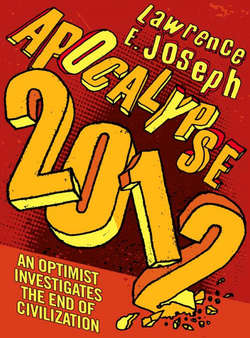Читать книгу Apocalypse 2012: An optimist investigates the end of civilization - Lawrence Joseph E. - Страница 11
THE MAYAN PROPHECIES
ОглавлениеAncient Mayan astronomy is anything but oojie-boojie. It is a staggering intellectual achievement, equivalent in magnitude to ancient Egyptian geometry or to Greek philosophy. Without telescopes or any other apparatus, Mayan astronomers calculated the length of the lunar month to be 29.53020 days, within 34 seconds of what we now know to be its actual length of 29.53059 days. Overall, the 2,000-year-old Mayan calendar is believed by many to be more accurate than the 500-year-old Gregorian calendar we use today.
The Maya were obsessed with time. Over the centuries, they devised at least twenty calendars, attuned to the cycles of everything from pregnancy to the harvest, from the Moon to Venus, whose orbit they calculated accurately to 1 day every 1,000 years. After centuries of observations, their astronomers came to the conclusion that on the winter solstice of 2012, 12/21/12, or 13.0.0.0.0 by what is known as their Long Count calendar, a new era in human history will commence. This 12/21/12 “stroke of midnight” begins a new age, just as the Earth’s completion of its orbit around the Sun brings a new year at the stroke of midnight every January 1. But so what? Aside from a change in date and a day off from work, there is no inherent, palpable difference between December 31 and January 1—it’s not as though we go from cold and dark one day to warm and sunny the next. For that matter, there is no inherent, palpable difference between one year and the next, unless such difference is externally ascribed: going from 1999 to 2000, Y2K was nothing but a transition from a digitally unremarkable number to a nice big round one. It proved to be about as spiritually resonant as an odometer change.
The date 12/21/12 has significance beyond numerical happenstance. It is the annual winter solstice, when the Northern Hemisphere is farthest away from the Sun, and when therefore there is the least daylight and the longest night. On that date our Solar System will eclipse—interpose itself so as to block the view from Earth—the center of the Milky Way. The dark hole at the center of the galaxy spiral was considered the Milky Way’s womb by the ancients and now also by contemporary astronomers, who believe that that’s the spot where our galaxy’s stars are created. Indeed, there’s a vast black hole right at the center, making for a nice navel motif.
The Mayan ancients held that 12/21/12 would begin a new age, in vital fact as well as calendar technicality. The date thus portends a most sacred, propitious, and dangerous moment in our history, destined, they believed, to bring both catastrophe and revelation. The years leading up to it presage this awesome potential in terrible and wonderful ways.
I went to Guatemala to evaluate the beliefs and predictions attached to 12/21/12 and concluded, in a nutshell, that the Maya have a track record that is impossible to ignore. Always give genius the benefit of the doubt, and the ancient Mayan astronomers were indeed geniuses. The Mayan prophecies concerning 2012 seem therefore to contain wisdom not necessarily beyond science, but most likely beyond anything contemporary scientific methodology could prove, or disprove, in the short time remaining before the apocalypse deadline.
What possessed the Maya to devote so much exquisite work to astronomy, while never even getting around, for example, to inventing the wheel or even simple metal tools, I cannot say. But simply to ignore their fundamental conclusion that December 21, 2012, is a pivotal date in human history—especially given the profoundly disturbing set of concurrences regarding the 2012 deadline in fields ranging from solar physics to Eastern philosophy—would be foolish in the extreme.
